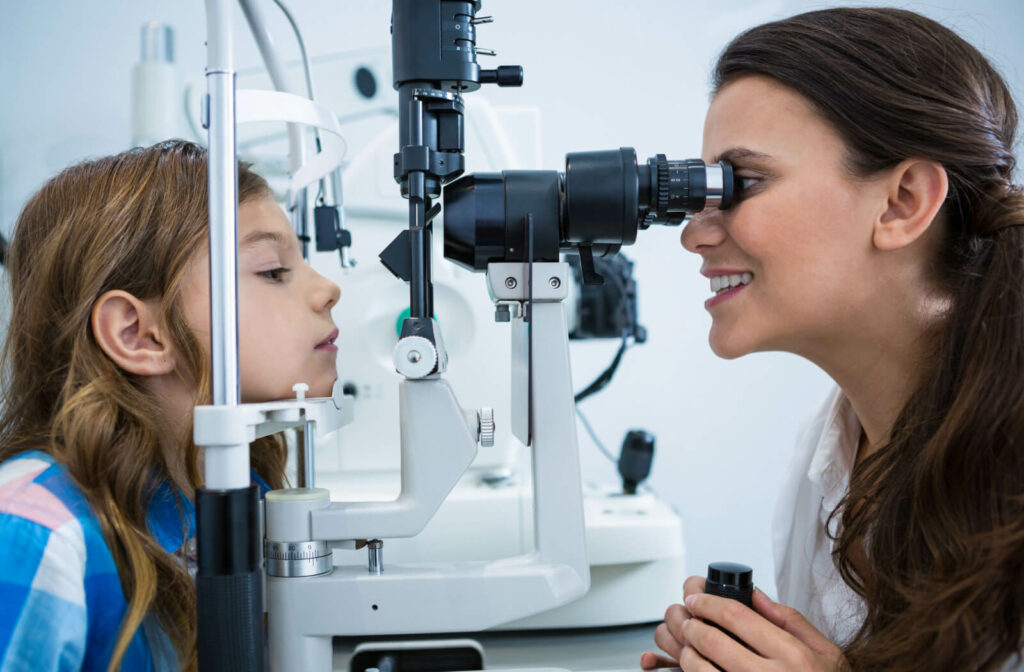Myopia (nearsightedness) is a refractive error when a person can’t see distant objects. Myopia is common, and its prevalence is increasing. It can lead to various eye health issues, so the goal is to manage myopia progression to help protect vision.
Myopia management is best done during childhood while the eyes are growing. It may include atropine eye drops, myopia control contact lenses and glasses, ortho-k lenses, and lifestyle changes. Children’s eye exams and myopia control can help prevent sight-threatening eye diseases and protect their eyesight into the future.
What Is Myopia?
Myopia is a refractive error that causes distant objects to appear blurry while nearby objects remain clear. It occurs when the eye grows too long or the cornea becomes too steep, causing light to focus behind the retina instead of on it.
As a result, the images a person sees are not sharp but instead blurred or distorted. Myopia usually begins developing in childhood, around 6 to 14 years. It progresses until early adulthood when overall growth slows and eyesight stabilizes.
What Causes Myopia?
Myopia is caused by a complex combination of genetic predisposition and environmental factors. If one or both of your parents have myopia, then you’re more likely to develop the condition, especially if the conditions are right.
Research shows that too much close work (like reading or writing) and not enough time spent outdoors during important developmental years can lead to myopia. Children who spend more time outdoors are less likely to develop myopia than those who spend most of their time indoors.
What Are the Symptoms of Myopia?
The most common symptom of myopia is difficulty seeing distant objects, such as the board at school, road signs, leaves on trees, or stars in the sky. Other signs and symptoms may include:
- Squinting
- Headaches
- Eye strain
- Eye fatigue
- Sensitivity to light
How Is Myopia Corrected?
It’s essential to get regular eye exams to detect any changes in your vision and prevent myopia from becoming worse over time.
There’s no cure for myopia. Once you have it, you can’t reverse it, but it’s easily corrected with eyeglasses or contact lenses. Patients over 18 may qualify for laser eye surgery, which involves surgically reshaping the cornea to correct how light enters the eyes.
Myopia Management Methods
Myopia progression can increase your risk of developing sight-threatening eye conditions, such as:
- Macular degeneration
- Cataracts
- Glaucoma
- Retinal detachment
Because of these risks, various myopia control methods are available to help slow or stop its progression during childhood.
Myopia Control Contact Lenses
These specialty contact lenses are designed specifically for children. They contain a higher focusing power in the center and less around the periphery. This is called “peripheral myopic defocus,” and may reduce myopia progression by up to 59%.
MiSight 1-day lenses are soft, daily contacts suitable for children as young as 8.
Myopia Control Eyeglasses
Myopia control spectacle lenses are specialty glasses that correct blurred vision caused by myopia and also help slow its progression in children and teenagers.
Traditional options like bifocals and progressive addition lenses have been used for myopia control, but advancements in lens technology have brought about new and emerging options. These lenses often include features like aspherical lenslets, which can slow down myopia progression and axial elongation compared to standard single-vision lenses.
Wearing aspherical lenslets can increase myopia control efficacy by 67% for spherical equivalent refraction.
Orthokeratology
Orthokeratology (ortho-k) involves specially designed and fitted rigid gas-permeable contact lenses to temporarily reshape the cornea, improving vision without needing glasses or daytime contact lenses. Children wear these specialized contacts while they sleep. The lenses gently reshape the cornea overnight, correcting myopia. When they wake up, they remove the lenses and can see clearly throughout the day without needing glasses or contacts.
Studies have shown that ortho-k can not only correct vision but also slow the progression of myopia over time. It is especially beneficial when started at a younger age.
Atropine Eye Drops
Atropine is a medication that has been traditionally used to dilate the pupils during eye exams. However, recent studies have shown that low-dose atropine eye drops can also help slow myopia progression in children. Atropine works by relaxing the muscles in the eye, which in turn helps to reduce the elongation of the eyeball that is associated with myopia.
Atropine is easy to use. It’s typically prescribed as a once-daily eye drop, usually applied before bedtime. The low concentration used for myopia control minimizes potential side effects such as light sensitivity.
Lifestyle Changes
Taking some proactive steps while your child is growing can help protect their vision:
- Encourage them to spend more time outdoors (at least 2 hours a day), engaging in activities like playing sports or simply exploring nature.
- Limit screen time and encourage regular breaks to give their eyes a rest.
- Make sure they maintain a proper distance from screens and use good lighting.
- Prioritize healthy habits like maintaining a balanced diet and getting enough sleep.

Myopia Control Options
30% of learning depends on vision, and vision problems can drastically impact their ability to learn. Management and control strategies can slow or halt myopia progression, protecting their long-term vision.
If your child has myopia, visit an eye doctor regularly to detect any changes or problems with their vision and seek prompt medical attention if they experience any persistent symptoms. Book an appointment with Los Angeles EyeCare Optometry to see if corrective lenses or myopia control can work for them.



